Strawberry
| Garden strawberry Fragaria × ananassa | |
|---|---|
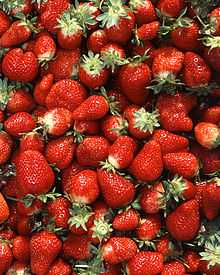 | |
| Garden strawberries, grown in California | |
| Scientific classification | |
| Kingdom: | Plantae |
| (unranked): | Angiosperms |
| (unranked): | Eudicots |
| (unranked): | Rosids |
| Order: | Rosales |
| Family: | Rosaceae |
| Subfamily: | Rosoideae |
| Genus: | Fragaria |
| Species: | F. × ananassa |
| Binomial name | |
| Fragaria × ananassa Duchesne | |
The garden strawberry (or simply strawberry /ˈstrɔːb(ə)ri/; Fragaria × ananassa) is a widely grown hybrid species of the genus Fragaria (collectively known as the strawberries). It is cultivated worldwide for its fruit. The fruit (which is not a botanical berry, but an aggregate accessory fruit) is widely appreciated for its characteristic aroma, bright red color, juicy texture, and sweetness. It is consumed in large quantities, either fresh or in such prepared foods as preserves, fruit juice, pies, ice creams, milkshakes, and chocolates. Artificial strawberry aroma is also widely used in many industrial food products.
The garden strawberry was first bred in Brittany, France, in the 1750s via a cross of Fragaria virginiana from eastern North America and Fragaria chiloensis, which was brought from Chile by Amédée-François Frézier in 1714.[1] Cultivars of Fragaria × ananassa have replaced, in commercial production, the woodland strawberry (Fragaria vesca), which was the first strawberry species cultivated in the early 17th century.[2]
Technically, the strawberry is an aggregate accessory fruit, meaning that the fleshy part is derived not from the plant's ovaries but from the receptacle that holds the ovaries.[3] Each apparent "seed" (achene) on the outside of the fruit is actually one of the ovaries of the flower, with a seed inside it.[3]
History
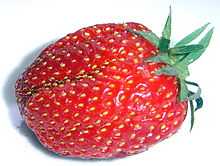
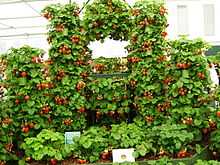
The first garden strawberry was grown in France during the late 18th century.[2] Prior to this, wild strawberries and cultivated selections from wild strawberry species were the common source of the fruit.
The strawberry fruit was mentioned in ancient Roman literature in reference to its medicinal use. The French began taking the strawberry from the forest to their gardens for harvest in the 1300s. Charles V, France's king from 1364 to 1380, had 1,200 strawberry plants in his royal garden. In the early 1400s western European monks were using the wild strawberry in their illuminated manuscripts. The strawberry is found in Italian, Flemish, German art, and English miniatures.[citation needed] The entire strawberry plant was used to treat depressive illnesses.
By the 1500s references of cultivation of the strawberry became more common. People began using it for its supposed medicinal properties and botanists began naming the different species. In England the demand for regular strawberry farming had increased by the mid-1500s. Instructions for growing and harvesting strawberries showed up in writing in 1578. By the end of the 1500s three European species had been cited; F. vesca, F. moschata, and F. viridis. The garden strawberry was transplanted from the forests and then the plants would be propagated asexually by cutting off the runners.
Two subspecies of F. vesca were identified; F. sylvestris alba and F. sylvestris semperflorens. The introduction of F. virginiana from Eastern North America to Europe in the 1600s is an important part of history because this species gave rise to the modern strawberry. The new species gradually spread through the continent and did not become completely appreciated until the end of the 18th century. When a French excursion journeyed to Chile in 1712, it introduced the strawberry plant with female flowers that resulted in the common strawberry that we have today.
The Mapuche and Huilliche Indians of Chile cultivated the female strawberry species until 1551 when the Spanish came to conquer the land. In 1765, a European explorer recorded the cultivation of F. chiloensis, the Chilean strawberry. At first introduction to Europe, the plants grew vigorously but produced no fruit. It was discovered in 1766 that the female plants could only be pollinated by plants that produced large fruit; F. moschata, F. virginiana, and F. ananassa. This is when the Europeans became aware that plants had the ability to produce male-only or female-only flowers. As more large-fruit producing plants were cultivated the Chilean strawberry slowly decreased in population in Europe, except for around Brest where the Chilean strawberry thrived. The decline of the Chilean strawberry was caused by F. ananassa.[4]
Cultivation
Strawberry cultivars vary widely in size, color, flavor, shape, degree of fertility, season of ripening, liability to disease and constitution of plant.[5] Some vary in foliage, and some vary materially in the relative development of their sexual organs. In most cases, the flowers appear hermaphroditic in structure, but function as either male or female.[6] For purposes of commercial production, plants are propagated from runners and, in general, distributed as either bare root plants or plugs. Cultivation follows one of two general models—annual plasticulture,[7] or a perennial system of matted rows or mounds.[8] A small amount of strawberries are produced in greenhouses during the off season.[9]
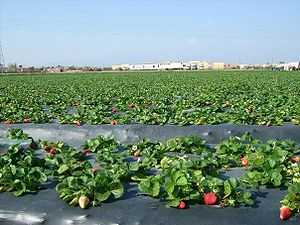
The other major method, which uses the same plants from year to year growing in rows or on mounds, is most common in colder climates.[7][8] It has lower investment costs, and lower overall maintenance requirements.[8] Yields are typically lower than in plasticulture.[8]
A third method uses a compost sock. Plants grown in compost socks have been shown to produce significantly higher oxygen radical absorbance capacity (ORAC), flavonoids, anthocyanins, fructose, glucose, sucrose, malic acid, and citric acid than fruit produced in the black plastic mulch or matted row systems.[11] Similar results in an earlier 2003 study conducted by the US Dept of Agriculture, at the Agricultural Research Service, in Beltsville Maryland, confirms how compost plays a role in the bioactive qualities of two strawberry cultivars.[12]
Strawberries are often grouped according to their flowering habit.[5][13] Traditionally, this has consisted of a division between "June-bearing" strawberries, which bear their fruit in the early summer and "ever-bearing" strawberries, which often bear several crops of fruit throughout the season.[13] Research published in 2001 showed that strawberries actually occur in three basic flowering habits: short-day, long-day, and day-neutral. These refer to the day-length sensitivity of the plant and the type of photoperiod that induces flower formation. Day-neutral cultivars produce flowers regardless of the photoperiod.[14]
Strawberries may also be propagated by seed, though this is primarily a hobby activity, and is not widely practiced commercially. A few seed-propagated cultivars have been developed for home use, and research into growing from seed commercially is ongoing.[15] Seeds (achenes) are acquired either via commercial seed suppliers, or by collecting and saving them from the fruit.
Strawberries can also be grown indoors in strawberry pots.
Kashubian strawberry (truskawka kaszubska or kaszëbskô malëna)[16] are the first Polish fruit to be given commercial protection under EU law. They are produced in Kartuzy, Kościerzyna and Bytów counties and in the municipalities of Przywidz, Wejherowo, Luzino, Szemud, Linia, Łęczyce and Cewice in Kashubia. Only the following varieties may be sold as kaszëbskô malëna: Senga Sengana, Elsanta, Honeoye that have been graded as Extra or Class I.
Manuring and harvesting
 A diorama created from beeswax by Dr. Henry Brainerd Wright at the Louisiana State Exhibit Museum in Shreveport, Louisiana depicts strawberry harvesting. Strawberries are particularly grown in the southeastern portion of the state around Hammond. |
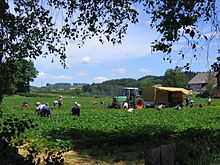 Harvest |
Most strawberry plants are now fed with artificial fertilizers, both before and after harvesting, and often before planting in plasticulture.[17]
To maintain top quality, berries are harvested at least every other day. The berries are picked with the caps still attached and with at least half an inch of stem left. Strawberries need to remain on the plant to fully ripen because they do not continue to ripen after being picked. Rotted and overripe berries are removed to minimize insect and disease problems. The berries do not get washed until just before consumption. They are covered in a shallow pan and refrigerated when storing.[18]
Soil test information and plant analysis results are used to determine fertility practices. Nitrogen fertilizer is needed at the beginning of every planting year. There are normally adequate levels of phosphorus and potash when fields have been fertilized for top yields. In order to provide more organic matter a cover crop of wheat or rye is planted in the winter the year before planting the strawberries. Strawberries prefer a pH from 5.5 to 6.5 so lime is usually not applied.[19]
The harvesting and cleaning process has not changed substantially over time. The delicate strawberries are still harvested by hand.[20] Grading and packing often occurs in the field, rather than in a processing facility.[20] In large operations, strawberries are cleaned by means of water streams and shaking conveyor belts.[21]
Pests
Around 200 species of pests are known to attack strawberries both directly and indirectly.[22] These pests include slugs, moths, fruit flies, chafers, strawberry root weevils, strawberry thrips, strawberry sap beetles, strawberry crown moth, mites, aphids, and others.[22][23]
The caterpillars of a number of species of Lepidoptera feed on strawberry plants.
Diseases
Strawberry plants can fall victim to a number of diseases.[24] The leaves may be infected by powdery mildew, leaf spot (caused by the fungus Sphaerella fragariae), leaf blight (caused by the fungus Phomopsis obscurans), and by a variety of slime molds.[24] The crown and roots may fall victim to red stele, verticillium wilt, black root rot, and nematodes.[24] The fruits are subject to damage from gray mold, rhizopus rot, and leather rot.[24] To prevent root-rotting, strawberries should be planted every four to five years in a new bed, at a different site.[25]
The plants can also develop disease from temperature extremes during winter.[24] When watering strawberries, advice has been given to water only the roots and not the leaves, as moisture on the leaves encourages growth of fungus.[26]
Production trends
| Rank | Country | 2006 | 2007 | 2008 | 2009 | 2010 | 2011 |
|---|---|---|---|---|---|---|---|
| 1 | |
1,090,436 | 1,109,215 | 1,148,350 | 1,270,640 | 1,294,180 | 1,312,960 |
| 2 | |
211,127 | 250,316 | 261,078 | 291,996 | 299,940 | 302,416 |
| 3 | |
330,485 | 269,139 | 281,240 | 266,772 | 275,355 | 262,730 |
| 4 | |
128,349 | 174,414 | 200,254 | 242,776 | 238,432 | 240,284 |
| 5 | |
191,843 | 176,396 | 207,485 | 233,041 | 226,657 | 228,900 |
| 6 | |
227,000 | 230,400 | 180,000 | 185,000 | 165,000 | 184,000 |
| 7 | |
190,700 | 191,400 | 190,700 | 184,700 | 177,500 | 177,300 |
| 8 | |
205,307 | 203,227 | 192,296 | 203,772 | 231,803 | 171,519 |
| 9 | |
193,666 | 174,578 | 200,723 | 198,907 | 153,410 | 166,159 |
| 10 | |
173,230 | 158,658 | 150,854 | 158,563 | 156,911 | 154,418 |
| 11 | |
143,315 | 160,558 | 155,583 | 163,044 | 153,875 | 150,000 |
| Total world | 3,973,243 | 4,001,721 | 4,136,802 | 4,596,614 | 4,366,889 | 4,594,539 |
 Fresh Strawberries from La Trinidad, Benguet, Philippines |
Domestic cultivation
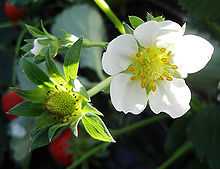
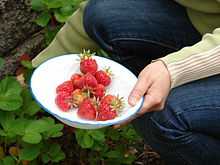
Strawberries are popular and rewarding plants to grow in the domestic environment, be it for consumption or exhibition purposes, almost anywhere in the world. The best time to plant is in late summer or spring. Plant in full sun or dappled shade, and in somewhat sandy soil. The addition of manure and a balanced fertilizer aids strong growth. Alternatively they can be planted in pots or special planters using compost. Fibre mats placed under each plant will protect fruits from touching the ground, and will act as a weed barrier.
Strawberries are tough and will survive many conditions, but during fruit formation, moisture is vital, especially if growing in containers. Moreover, protection must be provided against slugs and snails which attack the ripe fruit. The fruit matures in midsummer and should be picked when fully ripe — that is, the fruit is a uniform bright red colour. The selection of different varietes can extend the season in both directions.[28] Numerous cultivars have been selected for consumption and for exhibition purposes. The following cultivars have gained the Royal Horticultural Society's Award of Garden Merit:-
Propagation is by runners, which can be pegged down to encourage them to take root,[35] or cut off and placed in a new location. Established plants should be replaced every three years, or sooner if there are signs of disease.
When propagating strawberries, one should avoid using the same soil or containers that were previously used for strawberry cultivation. After cultivating strawberries, rotating to another culture is advisable, because diseases that attack one species might not attack another.[36]
Uses
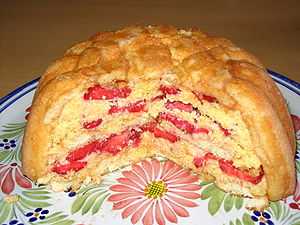
In addition to being consumed fresh, strawberries can be frozen, made into preserves, as well as dried and used in prepared foods, such as cereal bars.[37] Strawberries and strawberry flavorings are a popular addition to dairy products, such as strawberry-flavored milk, strawberry ice cream, strawberry milkshakes, strawberry smoothies and strawberry yogurts. Strawberries and cream is a popular dessert, famously consumed at Wimbledon. In Sweden, strawberries are a traditional dessert served on Midsummer Eve.[38] Depending on area, strawberry pie, strawberry rhubarb pie, or strawberry shortcake are also popular. In Greece, strawberries are usually sprinkled with sugar and then dipped in Metaxa, a famous brandy, and served as a dessert. In Italy, strawberries have been used for other desserts, especially for making strawberry tiramisu, a special form of the original tiramisu and as a popular flavoring for gelato (gelato alla fragola).
Strawberry juice is a fruit juice made from strawberries. Strawberry juice or concentrate is added to cocktails, such as Minute Maid Strawberry Passion and CoolBest Strawberry Hill.[citation needed]
Strawberry pigment extract can be used as a natural acid/base indicator due to the different color of the conjugate acid and conjugate base of the pigment.[39]
Strawberries contain fisetin, an antioxidant that has been studied in relation to Alzheimer's disease and to kidney failure resulting from diabetes.[40] Strawberries are the fruit that contains the highest amount of this antioxidant.[41] Fisetin lessens the complications of diabetes.[41] Strawberries can also help with heart disease and strokes.[42] Strawberries have a dark skin that has many antioxidants that help with heart disease.[42]
Nutrition
 | |
| Nutritional value per 100 g (3.5 oz) | |
|---|---|
| Energy | 136 kJ (33 kcal) |
| Carbohydrates | 7.68 g |
| - Sugars | 4.89 g |
| - Dietary fiber | 2 g |
| Fat | 0.3 g |
| Protein | 0.67 g |
| Thiamine (vit. B1) | 0.024 mg (2%) |
| Riboflavin (vit. B2) | 0.022 mg (2%) |
| Niacin (vit. B3) | 0.386 mg (3%) |
| Pantothenic acid (B5) | 0.125 mg (3%) |
| Vitamin B6 | 0.047 mg (4%) |
| Folate (vit. B9) | 24 μg (6%) |
| Choline | 5.7 mg (1%) |
| Vitamin C | 58.8 mg (71%) |
| Vitamin E | 0.29 mg (2%) |
| Vitamin K | 2.2 μg (2%) |
| Calcium | 16 mg (2%) |
| Iron | 0.41 mg (3%) |
| Magnesium | 13 mg (4%) |
| Manganese | 0.386 mg (18%) |
| Phosphorus | 24 mg (3%) |
| Potassium | 153 mg (3%) |
| Sodium | 1 mg (0%) |
| Zinc | 0.14 mg (1%) |
| Fluoride | 4.4 µg |
| Link to USDA Database entry Percentages are roughly approximated using US recommendations for adults. Source: USDA Nutrient Database | |
One cup (236 g) of strawberries contains approximately 45 kilo-calories (188 kJ) and is an excellent source of vitamin C and flavonoids.[43][44][45]
This fruit is very low in saturated fat, cholesterol and sodium. It is also a good source of folate and potassium, and a very good source of dietary fiber, and manganese[46] One serving of about eight strawberries provides more vitamin C than an orange. The strawberry is among the top 20 fruits in antioxidant capacity.[47]
Eating strawberries and other berry fruits appears to benefit the brain[48], cut heart attack risk in women[49], and reduce high blood pressure[50].
Allergy
Some people experience an anaphylactoid reaction to the consumption of strawberries.[51] The most common form of this reaction is oral allergy syndrome, but symptoms may also mimic hay fever or include dermatitis or hives, and, in severe cases, may cause breathing problems. Some research suggests that the allergen may be tied to a protein involved in the ripening of fruits, which was named Fra a1 (Fragaria allergen1). Homologous proteins are found in birch and apple, which suggests that people may develop cross-reactivity to all three species.
White-fruited strawberry cultivars, lacking Fra a1, may be an option for strawberry allergy sufferers. Since they lack a protein necessary for normal ripening, they do not produce the flavonoids that turn the mature berries of other cultivars red. They ripen but remain white, pale yellow or "golden", appearing like immature berries; this also has the advantage of making them less attractive to birds. A virtually allergen-free cultivar named 'Sofar' is available.[52][53]
Chemistry
Garden strawberries contain the dimeric ellagitannin agrimoniin which is an isomer of sanguiin H-6.[54][55]
Chemicals present in the fragrance of strawberries include; methyl acetate, ethyl acetate, methyl propanoate, isopropyl acetate, ethyl propanoate, methyl butyrate, (E)-2-pentenal, butyric acid, methyl isovalerate, 3-hexanone (IS), ethyl butyrate, n-hexanal, butyl acetate, methyl pentanoate, 2-methyl butanoic acid, isopropyl butanoate, ethyl 2-methylbutanoate, ethyl 3-methylbutanoate, (E)-hexanal, (E)-2-hexen-1-ol, 1-hexanol, isoamyl acetate, 2-methylbutyl acetate, 2-heptanone, propyl butyrate, ethyl pentanoate, 2-heptanol, amyl acetate, (E,E)-2,4-hexadienal, methyl hexanoate, hexanoic acid, benzaldehyde, butyl butyrate, ethyl hexanoate, (Z)-3-hexenyl acetate, hexyl acetate, (E)-2-hexenyl acetate, isopropyl hexanoate, ethyl-2-hexenoate, d-limonene, amyl butyrate, furaneol, heptanoic acid, mesifurane, propyl hexanoate, linalool, nonanal, methyl octanoate, octanoic acid, ocimenol, benzyl acetate, ethyl benzoate, butyl hexanoate, ethyl octanoate, octyl acetate, alpha-terpineol, isoamyl hexanoate, nonanoic acid, octyl butyrate, ethyl decanoate, decyl acetate, octyl butyrate, ethyl decanoate, decyl acetate, octyl isovalerate, beta-farnesene, gamma-decalactone, alpha-farnesene, (E)-nerolidol, octyl hexanoate, decyl butyrate, gamma-dodecalactone.[56]
See also
- California Strawberry Commission
- Fraise Tagada (strawberry-shaped candy popular in France)
- List of strawberry cultivars
- Musk Strawberry (hautbois strawberry)
- Plant City, Florida (winter strawberry capital of the world)
| |||||||||||||||||||
References
- ↑ "Strawberry, The Maiden With Runners". Botgard.ucla.edu.
- ↑ 2.0 2.1 Welsh, Martin. "Strawberries". Nvsuk.org.uk. Archived from the original on 2 August 2008.
- ↑ 3.0 3.1 Esau, K. (1977). Anatomy of seed plants. John Wiley and Sons, New York. ISBN 0471245208.
- ↑ Darrow, George M. "The Strawberry: History, Breeding and Physiology".
- ↑ 5.0 5.1 "G6135 Home Fruit Production: Strawberry Cultivars and Their Culture". University of Missouri.
- ↑ Fletcher, Stevenson Whitcomb (1917) Strawberry Growing, The Macmillan Co., New York, p. 127.
- ↑ 7.0 7.1 7.2 7.3 "Strawberry Plasticulture Offers Sweet Rewards". Ag.ohio-state.edu. 28 June 2002. Retrieved 5 December 2009.
- ↑ 8.0 8.1 8.2 8.3 "Strawberry Production Basics: Matted Row". newenglandvfc.org.
- ↑ "Pritts Greenhouse Berried Treasures". Hort.cornell.edu.
- ↑ 10.0 10.1 10.2 "Strawberry Fields Forever". Noble.org.
- ↑ Wang SW., Millner P. (2009). "Effect of Different Cultural Systems on Antioxidant Capacity, Phenolic Content, and Fruit Quality of Strawberries (Fragaria × aranassa Duch.)". Journal of Agricultural and Food Chemistry (ACS Publications) 57 (20): 9651–9657. doi:10.1021/jf9020575.
- ↑ Wang SY, Lin HS (November 2003). "Compost as a soil supplement increases the level of antioxidant compounds and oxygen radical absorbance capacity in strawberries". Journal of Agricultural and Food Chemistry 51 (23): 6844–50. doi:10.1021/jf030196x. PMID 14582984.
- ↑ 13.0 13.1 Sagers, Larry A. (15 April 1992). "Proper Cultivation Yields Strawberry Fields Forever". Deseret News. Archived from the original on 20 April 2007.
- ↑ Hokanson, S. C. and Maas, J. L. (2001). "Strawberry biotechnology". Plant Breeding Reviews: 139–179. ISBN 978-0-471-41847-4.
- ↑ Wilson, D.; Goodall, A.; Reeves, J. (1973). "An improved technique for the germination of strawberry seeds". Euphytica 22 (2): 362. doi:10.1007/BF00022647.
- ↑ "COUNCIL REGULATION (EC) No 510/2006 ‘TRUSKAWKA KASZUBSKA’ or ‘KASZËBSKÔ MALËNA’ EC No: PL-PGI-0005-0593-19.03.2007". European Union. 18 April 2009.
- ↑ "HS1116/HS370: Nitrogen Fertilization of Strawberry Cultivars: Is Preplant Starter Fertilizer Needed?". Edis.ifas.ufl.edu. 6 August 2007. Retrieved 5 December 2009.
- ↑ Bordelon, Bruce. "Growing Strawberries". Purdue University.
- ↑ "Production Guide for Commercial Strawberries". Iowa State University.
- ↑ 20.0 20.1 "Commercial Postharvest Handling of Strawberries (Fragaria spp.)". Extension.umn.edu.
- ↑ "Conveyors improve the fruits of processor's labors.(Frexport S.A. de C.V.)". AccessMyLibrary. 1 January 2000. Retrieved 5 December 2009.
- ↑ 22.0 22.1 "Insect Pests of Strawberries and Their Management". Virginiafruit.ento.vt.edu. 3 May 2000. Retrieved 5 December 2009.
- ↑ "Radcliffe's IPM World Textbook | CFANS | University of Minnesota". Ipmworld.umn.edu. 20 November 2009. Retrieved 5 December 2009.
- ↑ 24.0 24.1 24.2 24.3 24.4 "Strawberry Diseases". Extension.umn.edu.
- ↑ Pleasant, Barbara (2011). "All About Growing Strawberries". Mother Earth News (248): 23–25.
- ↑ Davis, Julie Bawden (2009). "Strawberry Success". Organic Gardening 56 (5): 52–56.
- ↑ "Faostat". Faostat.fao.org. 16 January 2013. Retrieved 9 March 2013.
- ↑ Klein, Carol (2009). Grow your own fruit. UK: Mitchell Beazley. p. 224. ISBN 9781845334345.
- ↑ "RHS Plant Selector Fragaria × ananassa 'Cambridge Favourite' (F) AGM / RHS Gardening". Apps.rhs.org.uk.
- ↑ "RHS Plant Selector Fragaria × ananassa 'Hapil' (F) AGM / RHS Gardening". Apps.rhs.org.uk.
- ↑ "RHS Plant Selector Fragaria × ananassa 'Honeoye' (F) AGM / RHS Gardening". Apps.rhs.org.uk.
- ↑ "RHS Plant Selector Fragaria × ananassa 'Pegasus' PBR (F) AGM / RHS Gardening". Apps.rhs.org.uk.
- ↑ "RHS Plant Selector Fragaria × ananassa 'Rhapsody' (F) AGM / RHS Gardening". Apps.rhs.org.uk.
- ↑ "RHS Plant Selector Fragaria × ananassa 'Symphony' PBR (F) AGM / RHS Gardening". Apps.rhs.org.uk.
- ↑ "Propagating Strawberry runners". Youtube. 6 June 2012.
- ↑ Takeguma, Massahiro. "Growing Strawberries". Retrieved 28 April 2013.
- ↑ Ree Drummond (2011). "Strawberry Oatmeal Bars". Food Network. Retrieved 27 March 2013.
- ↑ Name * (30 July 2013). "The Definitive Guide to Strawberry Picking in Scandinavia". Workinfinland.com. Retrieved 3 October 2013.
- ↑ "9. Acid-Base Indicators and pH". in Chemistry 1B Experiment 9 Alameda.peralta.edu
- ↑ Maher, P.; Dargusch, R.; Ehren, J. L.; Okada, S.; Sharma, K.; Schubert, D. (2011). "Fisetin Lowers Methylglyoxal Dependent Protein Glycation and Limits the Complications of Diabetes". In Deli, Maria A. PLoS ONE 6 (6): e21226. doi:10.1371/journal.pone.0021226. PMC 3124487. PMID 21738623.
- ↑ 41.0 41.1 "Flavonoids could represent two-fisted assault on diabetic complications and nervous system disorders: Salk Scientists Say: It's not an Apple a day after all – it's Strawberries!". Salk Institute for Biological Studies. 27 June 2011.
- ↑ 42.0 42.1 "Adopt a Brain-Healthy Diet". Alzheimer's Association.
- ↑ "Nutrition Facts and Analysis for Strawberries, raw". Nutritiondata.com.
- ↑ BonkeurInternet. "Strawberry Nutrition Facts. Health, Food, Diet". Thefruitpages.com.
- ↑ "Strawberry Nutrition". Sweetdarling.com. 14 July 1997. Retrieved 5 December 2009.
- ↑ Nutrition Facts and Analysis for Strawberries, raw. Nutritiondata.self.com. Retrieved on 31 December 2013.
- ↑ Nutritional Benefits of the Strawberry. Webmd.com. Retrieved on 31 December 2013.
- ↑ http://www.sciencedaily.com/releases/2012/03/120307145825.htm
- ↑ http://www.sciencedaily.com/releases/2013/01/130114152954.htm
- ↑ http://www.sciencedaily.com/releases/2011/01/110114155241.htm
- ↑ Robinson, Kerry (July/August 2003). "Food Safety, Healthy Eating and Nutrition Information". Food Insight, IFIC. Archived from the original on 16 April 2009.
- ↑ Hjernø K, Alm R, Canbäck B, Matthiesen R, Trajkovski K, Björk L, Roepstorff P, Emanuelsson C. (2006). "Down-regulation of the strawberry Bet v 1-homologous allergen in concert with the flavonoid biosynthesis pathway in colorless strawberry mutant". Proteomics 6 (5): 1574–87. doi:10.1002/pmic.200500469. PMID 16447153.
- ↑ Idea TV GmbH (21 June 2005). "The chemistry of strawberry allergy (includes 'Sofar' reference)". Innovations-report.com. Retrieved 9 March 2013.
- ↑ Vrhovsek, U.; Guella, G.; Gasperotti, M.; Pojer, E.; Zancato, M.; Mattivi, F. (2012). "Clarifying the Identity of the Main Ellagitannin in the Fruit of the Strawberry, Fragaria vesca and Fragaria ananassa Duch". Journal of Agricultural and Food Chemistry 60 (10): 2507–2516. doi:10.1021/jf2052256. PMID 22339338.
- ↑ Seeram, N. P.; Lee, R.; Scheuller, H. S.; Heber, D. (2006). "Identification of phenolic compounds in strawberries by liquid chromatography electrospray ionization mass spectroscopy". Food Chemistry 97: 1. doi:10.1016/j.foodchem.2005.02.047.
- ↑ Jouquand, Celine; Chandler, Plotto, Goodner (2008). "A Sensory and Chemical Analysis of Fresh Strawberries Over Harvest Dates and Seasons Reveals Factors that Affect Eating Quality". Amer. Soc. Hort. Sci. 133 (6): 859–867.
Further reading
- Khanizadeh, S. and J. DeEll. 2005. "Our Strawberries/ Les Fraisiers de Chez Nous ", A Description of Over 170 Strawberry Cultivars along with Regional Evaluation and Details Information Used for Plant Breeder’s Right Office. PWGSC, Publishing and Depository Services, Ottawa, Ont. ISBN 0-660-62338-2.
- Hancock, J.F. (1999). Strawberries (Crop Production Science in Horticulture). CABI. ISBN 978-0-85199-339-3
External links
| Look up strawberry in Wiktionary, the free dictionary. |
|
- F. ananassa data from GRIN Taxonomy Database
- Strawberries (Fact Sheet) (Berry Health Benefits Network)
 George Thurber (1879). "Strawberry". The American Cyclopædia.
George Thurber (1879). "Strawberry". The American Cyclopædia.
 "Strawberry". Encyclopædia Britannica (11th ed.). 1911
"Strawberry". Encyclopædia Britannica (11th ed.). 1911